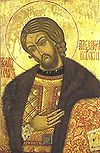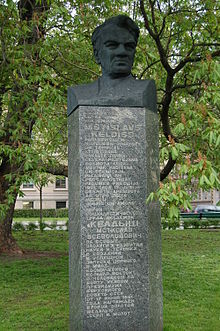- Mstislav Keldysh
-
Mstislav Vsevolodovich Keldysh (Russian: Мстисла́в Все́володович Ке́лдыш 10 February [O.S. 28 January] 1911, Riga - 24 June 1978, Moscow) was a Soviet scientist in the field of mathematics and mechanics, academician of the USSR Academy of Sciences (1946), President of the USSR Academy of Sciences (1961–1975), three times Hero of Socialist Labor (1956, 1961, 1971), fellow of the Royal Society of Edinburgh (1968). He was one of the key figures behind Soviet space program. Among scientific circles of USSR Keldysh was known with epithet "the Chief Theoretician"[1] in analogy with epithet "the Chief Designer" used for Sergey Korolyov.
Contents
Family
Keldysh was born to a professional family of Russian nobility. His grandfather, Mikhail Fomich Keldysh (1839–1920), was a military physician, who retired with the military rank of a General. Keldysh's grandmother, Natalia Keldysh (née Brusilova), was a cousin of famous general Aleksei Brusilov. Keldysh's maternal grandfather, Alexander Nikolaevich Skvortsov, was a General of Infantry, a hero of the Caucasian War.
Keldysh's father, Vsevolod Mikhailovich Keldysh (1878–1965), was a civil engineer, Major General of the Engineering Service, and a full Professor (since 1918, teaching at the Kuybyshev Military Engineering Academy. He was a Distinguished Engineering Scientist of Soviet Union (Заслуженный деятель науки и техники СССР) since 1944. He was one of the authors of contemporary methods for calculating the strength of reinforced concrete, and a designer of the Moscow Canal and Moscow Metro projects.
Several members of the Keldysh family were victims of political repressions. In the 1930s Keldysh's uncle was sent to a labor camp on the White Sea-Baltic Canal construction site. In 1935 Keldysh's mother was arrested but after a few weeks was released. It was a part of the campaign of collecting gold from the population, but after Keldysh's father brought all the jewelry the family had, the unsatisfied NKVD officer returned "all this garbage" back. Keldysh's brother Mikhail, a historian who specialized in medieval Germany, was arrested in 1936 and executed in 1937 as a "German spy." In 1938 another of Keldysh's brothers, Alexander, was arrested as a "French spy." Alexander was spared because of a small liberalization of the repressions during the transfer of the NKVD leadership from Nikolai Yezhov to Lavrenty Beria - he was acquitted in the court.
The strongest influence on Keldysh was his older sister, Ljudmila Keldysh (1904–1976), a noted mathematician and Keldysh's first teacher. Among her children (Keldysh's nephews) are Leonid Keldysh, director of Lebedev Physical Institute and Sergei Novikov, a famous mathematician.
Biography
Keldysh was born in 1911 in Riga. When he was four the family evacuated to Moscow during the First World War. In the first years of the Soviet Union he was refused entrance to an Institute of Civil Engineers because of his attachment to a noble family (1927). In the next years he managed to enter and graduate from the Physics and Mathematics department of the Moscow State University (24 July 1931). He obtained employment at the Central Aerohydrodynamic Institute (TsAGI) under Mikhail Lavrentyev and Sergei Chaplygin.
Working in TsAGI he explained the auto-oscillation effects of flutter (in-flight auto-induced oscillations and structural deformations), and shimmy (auto-oscillation in the nose-wheel of aircraft undercarriages while on the ground). Both works were mathematically beautiful and practical; both were important as both effects were responsible for many aircraft catastrophes at the time.
In 1937 Keldysh became Doctor of Science (his dissertation's title was Complex Variable and Harmonic Functions Representation by Polynomial Series) and a Professor of Moscow State University. In 1943 he became a Corresponding Member of the USSR Academy of Sciences. He got his first Stalin Prize in 1946 for his works on aircraft auto-oscillations. In 1943 he also became a full member of the Academy and the Director of NII-1 (Research Institute number 1) of the Department of the Aviation Industry. He also headed the Department of Applied Mechanics of the Steklov Institute for Mathematics (in 1966 the department became Institute for Applied Mechanics, named after Keldysh).
During the 1940s Keldysh became the leader of a unique group of applied mathematicians involved in almost all large scientific projects of the Soviet Union. He created the Calculation Bureau that carried most of the mathematical problems related to the development of nuclear weapons. The bureau is also credited with design of the first Soviet computers. In 1947 He became a member of Communist Party
Keldysh's main efforts were devoted to jet propulsion and rockets including supersonic gas dynamics, heat and mass exchange, heat shielding etc. 1959 saw successful testing of the Soviet first cruise missile, which displayed better performance than the Navajo missile being designed in USA at the time.
In 1954 Keldysh, Sergey Korolyov and Mikhail Tikhonravov submitted a letter to the Soviet Government proposing development of an artificial satellite to orbit the Earth. This letter began the effort that culminated in the world's first satellite, Sputnik in October 1957, which marks the beginning of mankind's Space Age. In 1955 Keldysh was appointed chairman of the Satellite Committee at the Academy of Science. In recognition of his contribution to the problems of defense Keldysh was awarded the Hero of Socialist Labor (1956) and the Lenin Prize (1957). In 1961 he received a second Него of Socialist Labor medal for his contribution to Yuri Gagarin's flight into space, the first person to orbit the earth.
In 1961 Keldysh was elected Chairman of the USSR Academy of Sciences and kept this position for 14 years. Concomittantly he became a member of the Central Committee of the Communist Party. Among his achievements were rehabilitation of genetics and cybernetics and support of dissident scientists including Andrei Sakharov.[citation needed] His last scientific works were devoted to creation of the Shuttle Buran. In 1962 He was elected a member of the Supreme Soviet of the Soviet Union.
Keldysh was 67 when he died. He was honoured with a state funeral and his ashes were buried in the Kremlin Wall Necropolis on Red Square.
Awards and honors
Keldysh was a member of many foreign academies of sciences, including the Mongolian Academy of Sciences (1961), Polish Academy of Sciences (1962), Czechoslovak Academy of Sciences (1962), and Romanian Academy of Sciences (1965). He was also an honorary member of the American Academy of Arts and Sciences (1966), Bulgarian Academy of Sciences (1966), Hungarian Academy of Sciences (1970), and Royal Society of Edinburgh (1968), foreign corresponding member of the German Academy of Sciences (1966), and Saxon Academy of Sciences in Leipzig (1966).
Keldysh was awarded the USSR State Prize (1942, 1946), Lenin Prize (1957), six Orders of Lenin, three other orders, numerous medals and four foreign orders.
The crater Keldysh on the Moon, and a research vessel Akademik Mstislav Keldysh are named after him. A minor planet, 2186 Keldysh discovered in 1973 by Soviet astronomer Lyudmila Chernykh, is named in his honor.[2]
See also
References
- ^ Boris Chertok, Missiles and people Online version
- ^ Schmadel, Lutz D. (2003). Dictionary of Minor Planet Names (5th ed.). New York: Springer Verlag. p. 178. ISBN 3-540-00238-3. http://books.google.com/books?q=2186+Keldysh+SQ4.
External links
- (Russian) Keldysh Institute for Applied Mathematics
- (English) M. V. Keldysh memorial page (at Keldysh Institute site)
- (Russian) Biography of Keldysh
- (Russian) Keldysh's family
- (Russian) Keldysh and Viktor Glushkov
Academic offices Preceded by
Alexander NesmeyanovPresident of the Russian Academy of Sciences
1961–1975Succeeded by
Anatoly AlexandrovPeople from Russia Leaders and religious - Pre-1168
- 1168–1917
- 1922–1991
- 1991–present
- RSFSR leaders
- General secretaries
- Soviet premiers (1st deputies)
- Soviet heads of state (and their spouses)
- Prime ministers (1st deputies)
- Foreign ministers
- Prosecutors general
- Metropolitans and patriarchs
- Saints

Military and explorers - Field marshals
- Soviet marshals
- Admirals
- Aviators
- Cosmonauts
Scientists and inventors - Aerospace engineers
- Astronomers and astrophysicists
- Biologists
- Chemists
- Earth scientists
- Electrical engineers
- IT developers
- Linguists and philologists
- Mathematicians
- Naval engineers
- Physicians and psychologists
- Physicists
- Weaponry makers
Artists and writers Sportspeople Chess playersCategories:- 1911 births
- 1978 deaths
- Early spaceflight scientists
- Fellows of the Royal Society of Edinburgh
- Heroes of Socialist Labour
- Moscow Institute of Physics and Technology faculty
- Moscow State University alumni
- People buried in the Kremlin Wall Necropolis
- People from Livonia
- People from Riga
- Russian inventors
- Russian scientists
- Soviet mathematicians
- Stalin Prize winners
Wikimedia Foundation. 2010.



